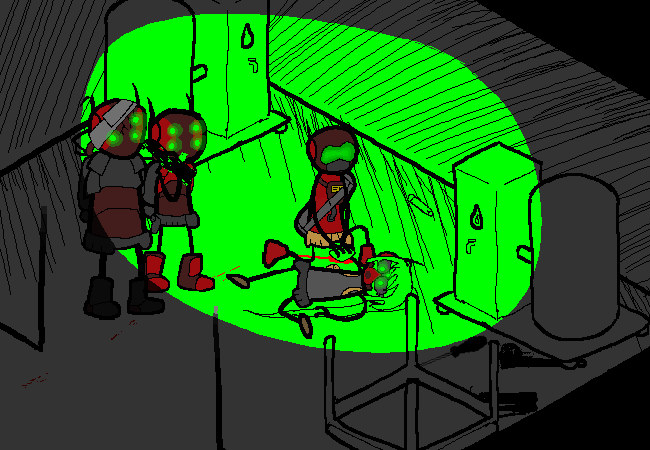 Neutron: Stab her with one of those, then bandage the bleeding.
Neutron: Stab her with one of those, then bandage the bleeding.
 Neutron: Stab her with one of those, then bandage the bleeding.
Neutron: Stab her with one of those, then bandage the bleeding.

She gasps into full consciousness, immediately speaking:
 WhiteDwarf: Arm... elevate it, elevate...
WhiteDwarf: Arm... elevate it, elevate...
 WhiteDwarf: Nanogauze pad, on my belt, look for...
WhiteDwarf: Nanogauze pad, on my belt, look for...
 RedDwarf:
RedDwarf:  WhiteDwarf!!
WhiteDwarf!!
 RedGiant: Oh thank god, she's--
RedGiant: Oh thank god, she's--
 WhiteDwarf: Not yet. Need... need more, gonna need to...
WhiteDwarf: Not yet. Need... need more, gonna need to...
The Unofficial Galactic Company Protocol Guide has this to say on the topic of modern medicine in space-based contexts:
Medicine in its contemporary form has become more like an art than a science. It was originally thought that medical science would be entirely solved through nanotechnology and other autonomous, self-diagnosing sources. These solutions, said the futurists, would be cheap, effective, self-replicating, and universally compatible. A galaxy-wide collaboration between many, many governments produced a variety of nanite designs capable of eliminating, or at least treating, nearly every type of wound, disease, defect, and infection. Humanity was now able to live with absolutely no sickness or pain.
IP rights for these nanites were immediately bought out for pennies on the dollar by a variety of corporate interests through extensive donations and a PR campaign, which emphasized to the population that freely available medical nanites would allow children to grow up with an advantage that the elderly had not had for a while, and thus was a form of tremendous disrespect to anyone who had ever paid for a doctor. They instituted an assortment of both hereditary and regional subscription models, as well as designing exclusive protocols in an effort to force each area and individual to subscribe only to their particular model of medical treatment.
The conflicting protocols, bloodline-inherited subscriptions, regional provisions, and DRM resulted in almost completely inconsistent physiological behaviors. On one space station, surgical tools bristle with potential infection, yet on another, infection presents nearly no risk. Cauterizations, incisions, and even chemical metabolizations don't have consistent behaviors, meaning safe procedures or medical chemistry in one system can be dangerous or lethal elsewhere.
As a result of this, surgeons and chemists are known for a "fast and loose" approach that is usually abhorrent to surface-dwellers. It can be unnerving, for obvious reasons, for one to receive no anesthesia where it might otherwise be needed because of a doctor's experience in another locale subscribed to pain-suppression, or for one to receive anesthesia where it isn't needed on a station with no sleep regulation subscription. But most concerning of all are debates between surgeons mid-surgery, or the occasional incidence of a surgeon accidentally cracking their patient over the head with a hemostat because of nanite auto-guidance mis-configurations.
Surgical saw manufacturers, on the other hand, experienced an unexpected windfall during the great medical fracturing: There are simply only so many ways a body can interact with a saw, and so standardizing that is the easiest thing in the galaxy.